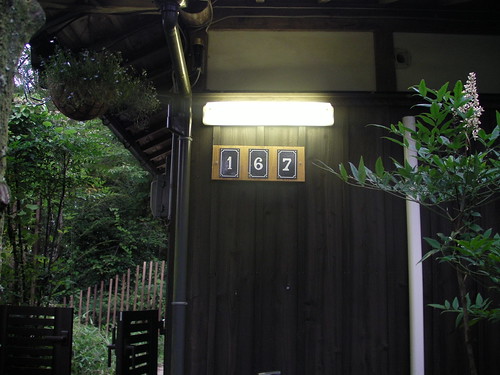Monday, June 25, 2012
The Only House Numbers in Town?
Rather than put my name, or our family name on our house, we chose to mimic the western street number system and put the plot number (banchi 番地) on our house. My wife felt that having a family or (worse) householder name on our house would result in our house being more difficult to visit. My wife feels, rightly I think, that proclaiming ownership through the use of a householder name plate (hyousatsu 表札), makes the house more private, more requiring of the named owner's permission to visit, and thus more difficult to enter ("with a higher floor level" shiki-i ga takai 敷居が高い). This relates to the fact that traditionally in Japan house visitation (house parties, dinner parties, having people drop in) is less popular.
Japanese houses are more private. I used to feel that the fact that people slept on the floor, on the tatami mats in Japanese houses, made me feel that entering someone's house was a bit more like entering their bed. Or rather, since houses are the space, place or field ("ba," Nakane, 1972; Bachnik & Quinn, 1994) that defines the family group, entering a house is a bit like suggesting that one is a member of the family.
Our house is in an area called "Itoyone", plot number 1-6-7 hence the numbers shown in the above image. My mother kindly sent us house numbers from France, where house numbers are commonplace, due to their lack of availability in Japan. Alas, since house numbers in France are street numbers, we were unable to purchase the hyphens required for a proper rendition of "1-6-7."
Added to the fact that Japanese streets lack names, making houses difficult to find, most Japanese do not even put their plot number on their house, making houses even more difficult to find. It is fairly often the case that people of the same family name live in the same vicinity so even if one has the family name of the householder, or if there is a delivery to someone other than the household patriarch, it must make it difficult for delivery staff to know which house is the one to deliver to. There are detailed maps showing which plot is which number, but why make things so difficult for delivery people?
Calling all Japanese people, why don't you put your house plot number on your house? Do you want to make your house difficult to find? 日本の方へ、なぜご自宅の番地を表札に、あるいは表札代わりに示してくださらないでしょうか?
Japan is however covered (see Nakashima, 1999) in signs, relating to business, apartment buildings (with a considerable amount of Western influence), and temple/shrine names.
Bachnik, J. M., & Quinn, C. J. (Eds.). (1994). Situated Meaning: Inside and Outside in Japanese Self, Society, and Language. Princeton University Press.
Nakane, C. (1972). Japanese Society (1st pb ed.). University of California Press.
Nakashima, Y. 中島, 義道. (1999). うるさい日本の私. 新潮社.
Japanese houses are more private. I used to feel that the fact that people slept on the floor, on the tatami mats in Japanese houses, made me feel that entering someone's house was a bit more like entering their bed. Or rather, since houses are the space, place or field ("ba," Nakane, 1972; Bachnik & Quinn, 1994) that defines the family group, entering a house is a bit like suggesting that one is a member of the family.
Our house is in an area called "Itoyone", plot number 1-6-7 hence the numbers shown in the above image. My mother kindly sent us house numbers from France, where house numbers are commonplace, due to their lack of availability in Japan. Alas, since house numbers in France are street numbers, we were unable to purchase the hyphens required for a proper rendition of "1-6-7."
Added to the fact that Japanese streets lack names, making houses difficult to find, most Japanese do not even put their plot number on their house, making houses even more difficult to find. It is fairly often the case that people of the same family name live in the same vicinity so even if one has the family name of the householder, or if there is a delivery to someone other than the household patriarch, it must make it difficult for delivery staff to know which house is the one to deliver to. There are detailed maps showing which plot is which number, but why make things so difficult for delivery people?
Calling all Japanese people, why don't you put your house plot number on your house? Do you want to make your house difficult to find? 日本の方へ、なぜご自宅の番地を表札に、あるいは表札代わりに示してくださらないでしょうか?
Japan is however covered (see Nakashima, 1999) in signs, relating to business, apartment buildings (with a considerable amount of Western influence), and temple/shrine names.
Bachnik, J. M., & Quinn, C. J. (Eds.). (1994). Situated Meaning: Inside and Outside in Japanese Self, Society, and Language. Princeton University Press.
Nakane, C. (1972). Japanese Society (1st pb ed.). University of California Press.
Nakashima, Y. 中島, 義道. (1999). うるさい日本の私. 新潮社.
Labels: japan, japanese culture, nihonbunka, 日本文化
This blog represents the opinions of the author, Timothy Takemoto, and not the opinions of his employer.

